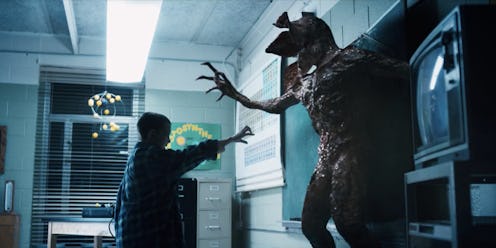
For those of you who haven't watched the Netflix sci-fi series Stranger Things yet, kindly do yourselves a favor and come back when you're all caught up with the country's current bingeworthy '80s-themed obsession. For those of us who have all finished devouring all Season 1 episodes at least once, there's only thing left to do while we wait for Netflix to renew the show for Season 2: speculate wildly about what's to come. There have been Stranger Things theories made about everything from Eleven's fate to the true nature of the Upside Down to what that season finale cliffhanger means for Will. But what about the creature that terrorized Hawkins, Indiana? What is the Stranger Things monster, exactly?
There's one fan theory making the rounds that seems to have that question all figured out… and the answer has to do with the X-Men. Eagle-eyed Reddit user aYearOfPrompts noticed an Easter egg in the very first episode of the series: a mention of X-Men #134, which Will plans to borrow from Dustin before he's abducted into the Upside Down. Some viewers might not have even registered which comic Will was talking about; others might have noticed, but chalked it up to simply another nerdy reference à la the gang's affinity for Dungeons & Dragons . But there might be a reason why that specific issue was chosen for the scene.
That's not just any old X-Men comic — that's an issue from the middle of one of the superheroes' most famous storylines, the Dark Phoenix Saga. In fact, #134 (published in June 1980) was the issue when psychic mutant Jean Grey finally and officially transformed into Dark Phoenix, her evil alter ego. This evolution came about after the villain Mastermind had been tinkering around in Jean's brain in an effort to unlock her full potential. He succeeded, but he got more than he bargained for when she became a force for pure destruction. At the end of #134, Mastermind's plan backfires when Dark Phoenix uses her newfound abilities to pin him against a wall and render the villain comatose.
I probably don't have to point out the copious similarities between that storyline and Eleven's story on Stranger Things. Like Mastermind, Dr. Brenner spent years tinkering around in Elle's brain in an effort to unlock her full potential. He succeeded, but got more than he bargained for when she encountered a force for pure destruction and let it into our world. At the end of Season 1, Mastermind's plan backfires when he's killed by the monster, and Elle uses her abilities to pin the monster against a wall until both she and it are disintegrated.
If the show is drawing a parallel between Eleven and Jean Grey, then what does that mean for the monster? In X-Men, there is no monster, just the dark side of Phoenix herself. Similarly, in Stranger Things, Elle says at one point that she is the monster. What if she wasn't speaking figuratively, but rather literally? What if Eleven didn't accidentally stumble across the monster during her psychic wanderings — what if she conjured it into existence with her own mental powers? Maybe the monster and the Upside Down didn't even exist until Eleven's tortured subconscious broke off and manifested into something terrifying.
Just like Mastermind's experiments allowed Jean's mind to unleash a dark power, perhaps Brenner's experiments allowed Elle's mind to summon a creature from her own nightmares and set it loose in the real world. If Eleven is responsible for creating the monster and we follow this Dark Phoenix parallel along to its logical conclusion… then that's not great news for our favorite telekinetic young girl. #134 doesn't end with Jean Grey vanquishing the Dark Phoenix; it ends with her embracing it. We have no idea what happened to Elle after she and the monster disappeared. What happened to Eleven in the Season 1 finale may not have ended her saga; rather, it may have simply destroyed any distinction that remained between her and the dark force she conjured up.
When we see Elle again next season, her words — "I am the monster" — may have proven sadly prescient.
Images: Netflix; Giphy (2)